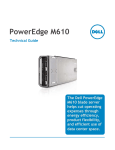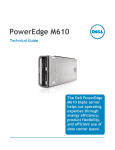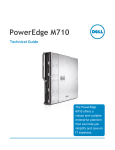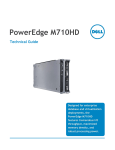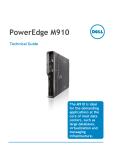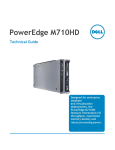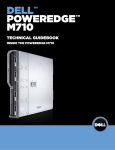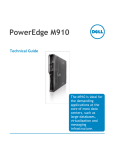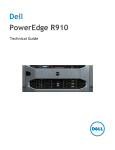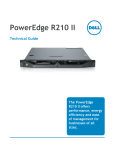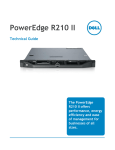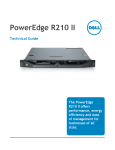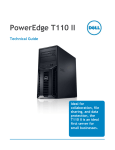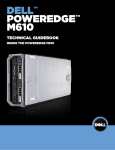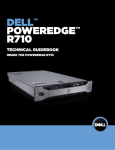Download Dell PowerEdge M610x System information
Transcript
PowerEdge M610x Technical Guide PCIe expansion capabilities in the PowerEdge M610x bring a new dimension of flexibility and performance to the Dell M-Series. Dell Dell, PowerEdge, EqualLogic, PowerVault, OpenManage, and ReadyRails are trademarks of Dell, Inc. Citrix and XenServer are registered trademarks of Citrix Systems, Inc. and/or one or more of its subsidiaries, and may be registered in the United States Patent and Trademark Office and in other countries. Intel, Xeon, and Speedstep are registered trademarks and MMX and Core are trademarks of Intel Corporation in the U.S. and other countries. Broadcom is a registered trademark and NetXtreme is a trademark of Broadcom Corporation and/or its affiliates in the United States, certain other countries and/or the EU. InfiniBand is a registered trademark and service mark of the InfiniBand Trade Association. Matrox is a registered trademark of Matrox Electronic Systems Ltd. Microsoft, Windows, Windows Server, BitLocker, and Hyper-V are either registered trademarks or trademarks of Microsoft Corporation in the United States and/or other countries. Mellanox and ConnectX are registered trademarks of Mellanox Technologies, Inc. Novell and SUSE are registered trademarks of Novell, Inc. in the United States and other countries. PCI Express is a registered trademark of PCISIG. Red Hat is a registered trademark of Red Hat, Inc. in the United States and other countries. Linux is a registered trademark of Linus Torvalds. NVIDIA is a registered trademark and Tesla is a trademark of NVIDIA Corporation in the U.S. and other countries. QLogic is a registered trademark of QLogic Corporation. VMware and vSphere are registered trademarks and ESX and ESXi are trademarks of VMware, Inc. in the United States and/or other jurisdictions. Other trademarks and trade names may be used in this document to refer to either the entities claiming the marks and names or their products. Dell disclaims proprietary interest in the marks and names of others. ©Copyright 2012 Dell Inc. All rights reserved. Reproduction or translation of any part of this work beyond that permitted by U.S. copyright laws without the written permission of Dell Inc. is unlawful and strictly forbidden. December 2012 | Version 6.0 Dell PowerEdge M610x Technical Guide ii Dell Table of Contents 1 Product Comparison ........................................................................................... 6 1.1 Overview .................................................................................................. 6 1.1.1 Unparalleled PowerEdge Flexibility ............................................................. 6 1.1.2 Uncompromised Performance .................................................................... 6 1.1.3 Simplified Systems Management ................................................................. 6 1.2 Product Comparison ..................................................................................... 7 2 Key Technologies............................................................................................... 9 2.1 Overview .................................................................................................. 9 3 System Information .......................................................................................... 10 4 Mechanical .................................................................................................... 13 4.1 Chassis Description..................................................................................... 13 4.2 Dimensions and Weight ................................................................................ 13 4.3 Internal Module View .................................................................................. 14 4.4 Security .................................................................................................. 14 4.5 Cover Latch ............................................................................................. 14 4.6 Trusted Platform Module.............................................................................. 14 4.7 Power Off Security ..................................................................................... 14 4.8 USB Key .................................................................................................. 14 4.9 Battery ................................................................................................... 14 4.10 Field Replaceable Units ............................................................................... 15 4.11 User Accessible Jumpers, Sockets, and Connectors ............................................... 15 5 Power, Thermal, Acoustic .................................................................................. 16 5.1 Power Supplies ......................................................................................... 16 5.2 Power Efficiency ....................................................................................... 16 5.3 Thermal Operating and Storage Specifications .................................................... 16 5.4 Acoustics ................................................................................................ 17 6 Processors ..................................................................................................... 19 6.1 Overview ................................................................................................ 19 6.2 Features ................................................................................................. 19 6.3 Supported Processors .................................................................................. 20 6.4 Processor Installation .................................................................................. 21 7 Memory ........................................................................................................ 22 7.1 Overview ................................................................................................ 22 7.2 DIMMs Supported ....................................................................................... 22 7.3 Memory Features ....................................................................................... 23 7.4 Speed .................................................................................................... 23 8 Chipset ........................................................................................................ 25 8.1 Overview ................................................................................................ 25 8.2 I/O Hub .................................................................................................. 25 8.2.1 QuickPath Interconnect ......................................................................... 25 8.2.2 PCI Express ........................................................................................ 25 8.2.3 Direct Media Interface........................................................................... 25 8.2.4 I/O Controller Hub 9 ............................................................................. 25 8.2.5 PCI Express Mezzanine Connectors ............................................................ 26 9 BIOS ............................................................................................................ 27 9.1 Overview ................................................................................................ 27 9.2 Supported ACPI States ................................................................................. 27 10 Embedded NICs/LAN on Motherboard ..................................................................... 28 Dell PowerEdge M610x Technical Guide iii Dell 11 I/O Mezzanine Card Options ................................................................................ 11.1.1 Overview .......................................................................................... 11.1.2 Options ............................................................................................ 11.1.3 PCIe Card Support ................................................................................ 11.1.4 GPGPU Cards ...................................................................................... 11.1.5 Fusion-io Cards ................................................................................... 12 Storage ........................................................................................................ 12.1 Overview ................................................................................................ 12.2 Hard Disk Drive Carriers ............................................................................... 12.3 Empty Drive Bays ....................................................................................... 12.4 Diskless Configuration Support ....................................................................... 12.5 Hard Drive LED Indicators ............................................................................. 12.6 Optical Drives ........................................................................................... 12.7 RAID Cards .............................................................................................. 12.7.1 SATA Repeater .................................................................................... 12.7.2 PERC6/i ............................................................................................ 12.7.3 H200 ................................................................................................ 12.7.4 H700 and H800 .................................................................................... 12.8 LED Indicators .......................................................................................... 12.9 Optical Drives ........................................................................................... 13 Video ........................................................................................................... 14 Rack Information ............................................................................................. 15 Operating Systems ........................................................................................... 16 Virtualization ................................................................................................. 16.1 Resources................................................................................................ 16.2 Advanced Infrastructure Manager by Scalent ...................................................... 17 Systems Management ........................................................................................ 17.1 Overview ................................................................................................ 17.2 Server Management .................................................................................... 17.3 Embedded Server Management ...................................................................... 17.4 Lifecycle Controller and Unified Server Configurator ............................................ 17.5 Integrated Dell Remote Access Controller.......................................................... 17.6 iDRAC6 Enterprise ...................................................................................... 17.7 iDRAC6 Enterprise with Virtual Flash (vFlash) Media ............................................. 17.8 Chassis Management Controller (CMC) .............................................................. 18 Peripherals .................................................................................................... 18.1 USB Peripherals......................................................................................... 18.2 External Storage........................................................................................ Appendix A. Statement of Volatility .......................................................................... Appendix B. Certifications ..................................................................................... B 1. Regulatory Certifications ............................................................................. B 2. Product Safety Certifications ......................................................................... B 3. Electromagnetic Compatibility ....................................................................... B 4. Ergonomics, Acoustics and Hygienics ............................................................... Appendix C. Industry Standards ............................................................................... 29 29 29 29 29 30 31 31 31 31 31 31 31 32 32 32 32 32 32 32 33 34 35 36 36 36 37 37 37 38 38 39 39 39 41 42 42 42 43 49 49 49 50 50 51 Tables Table 1. Table 2. Table 3. Product Comparisons ................................................................................. 7 Product Features .................................................................................... 10 Operating and Storage Specifications ............................................................ 17 Dell PowerEdge M610x Technical Guide iv Dell Table 4. Table 5. Table 6. Table 7. Table 8. Table 9. Table 10. Table 11. Table 12. Table 13. Table 14. Table 15. Table 16. Acoustical Performance of M1000e Chassis with Four M610x Blades Installed ............. Comparison of Processor Technology ............................................................ Supported Processors ............................................................................... Maximum Supported Memory Frequencies ...................................................... Supported Video Modes ............................................................................ Server Management Documentation and Information.......................................... Unified Server Configurator Features and Description......................................... Features List for Base Management Functionality, iDRAC, and vFlash Media .............. PowerEdge M610x Statement of Volatility....................................................... Product Safety Certifications ...................................................................... Electromagnetic Compatibility Certifications ................................................... Ergonomics, Acoustics and Hygienics............................................................. Industry Standards .................................................................................. 18 20 20 24 33 37 38 39 43 49 50 50 51 Figures Figure 1. Figure 2. Figure 3. PowerEdge M1000e ................................................................................. 13 Internal View ........................................................................................ 14 2.5‖ HDD Carrier .................................................................................... 31 Dell PowerEdge M610x Technical Guide v Dell 1 Product Comparison 1.1 Overview With PCI Express® (PCIe) expansion options and a feature rich Chassis Management Controller, the Dell™ PowerEdge™ M610x allows you to efficiently run applications, consolidate your data center, and simplify data management. The PowerEdge M610x enables you to incorporate a vast array of PCIe-based products into the blade chassis framework with enough power and cooling to efficiently deploy even the most feature-rich, expansion-card-based solutions. With the addition of the PCIe expansion module, the PowerEdge M610x blade server is an ideal solution for organizations that need maximum flexibility and performance with high reliability. Maximized PCIe Generation 2 (Gen2) expansion is finally realized within a blade. 1.1.1 Unparalleled PowerEdge Flexibility The PowerEdge M610x PCIe expansion module includes two full-length x16 PCIe Gen2 slots with supplemental power connectors that enable maximum wattage for one 300W dual-slot card or two 250W single-slot cards. These PCIe slots are capable of supporting everything from H-series external RAID controllers to general-purpose computing-on-graphics processing units (GPGPU). Now, a single M610x, equipped with a NVIDIA® Tesla™ or AMD ATI FirePro™ GPU card, can perform over 400 Gigaflops of double-precision computations for demanding, floating-point-intensive workloads. Communication between the host system and the GPU processors is maximized by providing x16 PCIe Gen2 bandwidth, while the efficient Dell M1000e chassis powers and cools the solution to its maximum 247 W TDP (Thermal Design Power). 1.1.2 Uncompromised Performance The PowerEdge M610x is an energy-efficient, optimized full-height two-socket server for virtualization and database applications. Additional manageability features make it easy to use, manage and deploy. As an ideal PCIe Host server, the M610x features the reliability of two 2.5‖ SAS or SSD hot-swappable hard drives and the I/O throughput of a dual-port embedded gigabit NIC and two additional network daughtercards. Intel® Xeon® processors 5600 series, plus up to 192 GB of DDR3 memory, offer high performance with low-power consumption for a variety of dense-environment workloads. The Platinum level (+94%) powered and modularly cooled PCIe expansion module delivers up to 8 GB per second of application throughput. 1.1.3 Simplified Systems Management Spend more time on your business and less on maintaining your IT with embedded system management features on the PowerEdge M610x and the Chassis Management Controller (CMC). Simplified server and chassis management is achieved through automated discovery that automates configuration of new hardware through a one-to-many relationship and enables pre-provisioning of LAN/SAN resources. In addition, one-to-many updating through the CMC and Virtual File Share simplifies the update process for BIOS, firmware and drivers without additional software. Proactive management provides immediate access to system status, issues and alerts through a single, easy-to-use interface that includes one-click key functions to help quickly resolve issues. Dell PowerEdge M610x Technical Guide 6 Dell 1.2 Product Comparison Table 1 compares the PowerEdge M610x blade server to the PowerEdge M610x, M710HD, and M710 servers. Table 1. M610x Product Comparisons M610 Description Special purpose full-height 2S General purpose half-height 2S Processor Intel® Xeon® Processor 5500 or 5600 Series Front Side Bus Two Intel QuickPath Interconnect (QPI) Sockets Two Cores per Socket Up to six L2/L3 Cache 8 MB (5500 Series) or 12 MB (5600 Series) Chipset Intel 5520 DIMMs 12 x DDR3 DIMMs (800/1066/1333MT/s) Min/Max RAM 1 GB – 192 GB (16 GB DIMMS) Form Factor Full-Height Blade, Dual Socket/Expansion module HDD Bays (2.5” only) SAS: Two hot-pluggable 2.5‖ SATA: One 2.5‖ HDD Types SAS/SSD HDD Controller PERC Η200 PERC Η700 PERC Η800 SAS6/Ε Optional HD Controller SAS6/iR PERC6/i with RAID battery Half-Height Blade, Dual Socket General purpose half-height 2S M710 General purpose full-height 2S 18 x DDR3 DIMMs (800/1066/1333MT/s) Half-Height Blade, Dual socket Full-Height Blade, Dual Socket SAS: Two hot-pluggable 2.5‖ SSD SATA: Two 2.5‖ SAS: Four hot-pluggable 2.5‖ SSD SATA: Two 2.5‖ PERC H200 PERC Η700 PERC 6/i SAS6/iR CERC 6/i Embedded PERC H200 PERC H200 PERC H700 CERC 6/i SAS6/iR PERC6/i with RAID battery Embedded H200 SAS6/iR PERC6i with RAID battery Availability Server M710HD Hot-plug hard drives ECC memory Single Device Data Correction (SDDC) Supports memory demand and patrol scrubbing High-availability failover cluster support Integrated Dell Remote Access Controller iDRAC6 Express/Enterprise (both standard) with Dell PowerEdge M610x Technical Guide 7 Dell M610x M610 M710HD M710 Management IPMI 2.0 +vMedia/vKVM, and CMC (on the PowerEdge M1000e chassis) Mezz Slots Two x8 PCIe Gen2; Fabric B limited to a small form factor (SFF) mezzanine card Two x8 PCIe Gen2; Fabric B limited to a small form factor (SFF) mezzanine card Two x8 PCIe mezzanine cards One x4 and three x8 PCIe mezzanine cards I/O slots Two x16 PCIe Gen2 H800/6 GB SAS NVIDIA® M2050204, M2070, and M2070Q AMD FirePro™ V7800P NA NA NA RAID 0,1 0,1 0,1 0,1,5 NIC/LOM Two-port Broadcom® 5709S 1 Gb with TOE plus optional iSCSI accelerator Two-port Broadcom 5709S 1 Gb with TOE plus optional iSCSI accelerator Four 1 GbE dual Broadcom BCM5709S Four TOE with optional iSCSI offload USB Two external USB 2.0 ports at front bezel One internal USB port SD Card Two: One for Persistent Storage One for Management TPM Yes, except in China where TCM is the standard Video Matrox® G200eW integrated into iDRAC chip Power Supplies See the PowerEdge M1000e Technical Guide. Fans See the PowerEdge M1000e Technical Guide. Chassis See the PowerEdge M1000e Technical Guide. Two: One for Persistent Storage One for Management Dell PowerEdge M610x Technical Guide Three external USB 2.0 ports at front bezel One internal USB port Two internal SD slots One for Persistent Storage One for Management (can also be configured as redundant SD cards for embedded hypervisor) One internal SD slot One for Persistent Storage OR One for Management 8 Dell 2 Key Technologies 2.1 Overview The Dell™ PowerEdge™ M610x offers you expandability. The M610x is a half-height blade (based on the M610 server technology) and PCIe card expansion module within a PowerEdge M1000e full-height blade enclosure that provides the capability to use standard PCIe cards. Similar to the PowerEdge M610, the PowerEdge M610x features: Dual quad- and six-core Intel® Xeon® processor 5500 and 5600 series Intel IOH (24D I/O Hub) Intel QuickPath Architecture DDR3 memory DIMM thermal sensors PCI Express® Generation 2 Internal SD Module iDRAC6 Express The M610x incorporates the system board of the M610 plus a PCI module—two x16 PCIe slots. The module’s 2nd Generation expansion slots can accommodate any standard full-length or full-height PCIe card. Supplemental power connectors allow, for the first time in the PowerEdge family, up to two 250W-PCIe cards or one 350W-PCIe card (inclusive of General-Purpose computation on Graphics Processing Units or GPGPU). Dell PowerEdge M610x Technical Guide 9 Dell 3 System Information Table 2 summarizes the product features for the Dell™ PowerEdge™ M610x. For the latest information on supported features, visit Dell.com. Table 2. Product Features Feature Technical Specifications Processors Intel® Xeon® processor 5500 and 5600 series quad- and six-core 60 W, 80 W, 95 W, and 130 W TDP options Chipset Intel 5520 Memory1 1 GB, 2 GB, 4 GB, 8 GB, 16 GB 1066 MT/s and 1333 MT/s DDR3 12 DIMM slots with support for up to 192 GB using RDIMMs Drive Bays Two 2.5‖ SAS/Solid State hot-plug drives Storage1 Internal hot-plug hard drive options: 2.5‖ SAS (10 K rpm): 146 GB, 300 GB, 600 GB, or 900 GB 2.5‖ SAS (15 K rpm): 146 GB 2.5‖ SATA (7.2 K rpm): 160 GB, 250 GB, or 500 GB Solid State Drives (SSD): 50 GB or 100 GB Solid State Storage Cards: Fusion-io® 160 GB ioDrive PCIe solid state storage card Fusion-io 640 GB ioDrive Duo PCIe solid state storage card Fusion-io 320GB ioDrive Mono PCIe solid state storage card Fusion-io 640GB ioDrive Mono PCIe solid state storage card Fusion-io 1.28TB ioDrive Duo PCIe solid state storage card Maximum Internal Disk Storage: Up to 1.8 TB using two 2.5‖ 900 GB hot-plug SAS hard drives RAID Controller Options PERC H200 Modular RAID Controller (6 Gb/s) PERC H700 Modular RAID Controller (6 Gb/s) with 512 MB battery-backed cache I/O Mezzanine Card Options Fully populated mezzanine card slots and switch modules will yield three redundant I/O fabrics per blade. 1 Gb and 10 Gb Ethernet: Dual-Port Broadcom® Gb Ethernet with TOE (BCM-5709S) Quad-Port Intel Gb Ethernet Quad-Port Broadcom Gb Ethernet (BCM-5709S) Dual-Port Intel 10Gb Ethernet Dual-Port Broadcom 10Gb Ethernet (BCM-57711) 10Gb Enhanced Ethernet and Converged Network Adapters (CEE/DCB/FCoE): Dual-Port Intel 10Gb Enhanced Ethernet (FcoE Ready for Future Enablement) Dual-Port Emulex® Converged Network Adapter (OCM10102-F-M; supports CEE/DCB Dell PowerEdge M610x Technical Guide 10 Dell Feature Technical Specifications 10GbE + FcoE) Dual-Port Qlogic® Converged Network Adapter (QME8142; supports CEE/DCB 10GbE + FcoE) Fibre Channel: Dual-Port QLogic FC8 Fibre Channel Host Bus Adapter (HBA) (QME2572) Dual-Port Emulex FC8 Fibre Channel Host Bus Adapter (HBA) (LPe1205-M) Emulex 8 or 4 Gb/s Fibre Channel Pass-Through Module InfiniBand™: Dual-Port Mellanox® ConnectX®-2 Dual Data Rate (DDR) and Quad Data Rate (QDR) InfiniBand Communications Two embedded Broadcom NetXtreme II™ 5709 Gigabit Ethernet NICs with failover and load balancing. TOE (TCP/IP Offload Engine) supported on Microsoft ® Windows Server® 2003 SP1 or higher with Scalable Networking Pack. iSCSI Offload supported on Windows Server ® 2003 SP1 or higher, Red Hat® Enterprise Linux® 5, and SUSE® Linux® Enterprise Server 10. Scalable Networking Pack for Windows Server ® 2003 is not required. Boot from SAN (iSCSI and FC) supported Optional add-in NICs: See I/O Mezzanine Card Options Optional add-in HBAs: See I/O Mezzanine Card Options Two 2nd-generation full-length x16 slots with supplemental power for either two cards at 250 W draws or one card at a 300 W draw. PCIe Expansion Bay Supported GPU Options: NVIDIA® Tesla™ M2050–204 448 core, double-width PCIe card with 3GB of memory NVIDIA Tesla M2070/M2070Q 448 core, double-width PCIe card with 6GB of memory AMD FirePro™ V7800P 1,440 core, singlewidth PCIe card with 2GB of memory SAS/PERC Options: Dell H800 PERC dual-port 6 Gb/s SAS RAID controller with up to 512MB cache Dell SAS6E HBA dual-port 6 Gb/s SAS HBA Operating Systems Solid State Storage Options: Fusion-io® 160GB ioDrive PCIe solid state storage card Fusion-io® 320GB ioDrive PCIe solid state storage card Fusion-io® 640GB ioDrive PCIe solid state storage card Fusion-io® 640GB ioDrive Duo PCIe solid state storage card Fusion-io® 1.28TB ioDrive Duo PCIe solid state storage card Microsoft Windows Server® 2012 Microsoft Windows Server 2008 SP2, x86/x64 (x64 includes Hyper-V® ) Microsoft Windows Server 2008 R2 SP1, x64 (includes Hyper-V v2) Microsoft Windows HPC Server 2008 Novell® SUSE® Linux Enterprise Server Red Hat® Enterprise Linux® Oracle® Solaris™ Dell PowerEdge M610x Technical Guide 11 Dell Feature Technical Specifications For more information on the specific versions and additions, visit Dell.com/OSsupport. Virtualization OS Support Citrix® XenServer® Microsoft Hyper-V through Microsoft Windows Server 2008 VMware® vSphere® including ESX™ and ESXi™ Red Hat Enterprise Virtualization® Management Options Dell OpenManage™ software tools Dell Management Console Integration with 3rd party management solutions via the Dell Certified Partner Program Altiris™ Deployment Solution for Dell Blade Servers Designed to help reduce deployment time from hours to minutes Integrated Dell Remote Access Controller (iDRAC) Out-of-Band alerting, status, inventory, and troubleshooting via Secure Web GUI / CLI (telnet/SSH) Console Redirection vMedia (virtual media)—Map optical or hard drives to the blade from remote workstations over a network vKVM (virtual KVM) out-of-band remote console redirection—supports Java or ActiveX plug-ins IPMI 2.0 support Power Supply Supplied by Dell PowerEdge M1000e Blade Chassis Video Integrated Matrox® G200 w/ 8 MB memory Systems Management BMC, IPMI2.0 compliant Dell OpenManage featuring Dell Management Console Unified Server Configurator Lifecycle Controller iDRAC6 Enterprise with optional vFlash 1 GB means 1 billion bytes and TB equals 1 trillion bytes; actual capacity varies with preloaded material and operating environment and will be less. Dell PowerEdge M610x Technical Guide 12 Dell 4 Mechanical 4.1 Chassis Description The Dell™ PowerEdge™ M610x is a full-height blade server that requires an M1000e chassis to operate. Figure 1. PowerEdge M1000e The M610x server occupies two slots in the M1000e rack chassis for a maximum of eight blades in one M1000e chassis. It can be mixed with other existing Dell blades and is designed to mix with possible future half- and full-height double-wide blades. Some highlights are: Two full-size standard PCIe x16 Front-cable access provided for add-in cards Support for RAID Support for persistent storage (internal USB connector and two external SD card slots) Refer to the PowerEdge M1000e Technical Guide for information on fans, power and power supply, racks, security, and other chassis information. 4.2 Dimensions and Weight The PowerEdge M610x dimensions and weight are as follows: Height: 38.5cm (15.2in) Width: 5cm (2in) Depth: 48.6cm (19.2in) Weight (Maximum Configuration): 11.1kg (24.5lb) Dell PowerEdge M610x Technical Guide 13 Dell 4.3 Internal Module View A view of the internal module is shown in Figure 2. See the Opening and Closing the Blade in the Dell PowerEdge Modular Systems Hardware Owner’s Manual on Support.Dell.com/Manuals for more information. Figure 2. Internal View 4.4 Security The M610x offers a configurable client IP address range for clients connecting to iDRAC6. For additional information regarding the PowerEdge M610x security features, see the Dell PowerEdge Modular Systems Hardware Owner’s Manual on Support.Dell.com/Manuals. 4.5 Cover Latch The blade module includes a latch for the cover. See the Opening and Closing the Blade in the Dell PowerEdge Modular Systems Hardware Owner’s Manual on Support.Dell.com/Manuals for more information. 4.6 Trusted Platform Module The Trusted Platform Module (TPM) is used to generate/store keys, protect/authenticate passwords, and create/store digital certificates. TPM can also be used to enable the BitLocker™ hard drive encryption feature in Windows Server 2008. TPM is enabled through a BIOS option and uses HMACSHA1-160 for binding. TCM is available in China. 4.7 Power Off Security Through the BIOS, the front blade server USB ports and power button can be disabled so as to not allow any control of the system from the front of the blade. The enclosure video can also be restricted. The BIOS System Setup program’s system security screen allows administrators to set the system password, control TPM activation and reporting, clear the TPM’s memory, and disable the power button and USB ports. 4.8 USB Key The M610x provides an internal USB connector for a USB flash memory key. The USB memory key can be used as a boot device, security key, or mass storage device. 4.9 Battery A replaceable coin cell CR2032 3V battery is mounted on the planar to provide backup power for the Real-Time Clock and CMOS RAM on the ICH9 chip Dell PowerEdge M610x Technical Guide 14 Dell 4.10 Field Replaceable Units The planar contains a serial EEPROM to contain Field Replaceable Units (FRU) information including Dell part number, part revision level, and serial number. 4.11 User Accessible Jumpers, Sockets, and Connectors For information, see the System Board Information chapter in the Dell PowerEdge Modular Systems Hardware Owner’s Manual on Support.Dell.com/Manuals. Dell PowerEdge M610x Technical Guide 15 Dell 5 Power, Thermal, Acoustic 5.1 Power Supplies See the PowerEdge M1000e Technical Guide for information on power supplies and power supply specifications. 5.2 Power Efficiency One of the main features of blade servers is enhanced power efficiency. The Dell™ PowerEdge™ M610x achieves higher power efficiency by implementing the following features: • • • • • • • • • • • • • • User-configurable power options through the M1000e Chassis Management Controller (CMC) (see the M1000e documentation online at Support.Dell.com for further details) Improved power budgeting Voltage Regulator (VR) efficiency improvements CPU VR dynamic phase shedding Switching regulators instead of linear regulators Closed loop thermal throttling Use of DDR3 memory (lower voltage compared to DDR2) Memory VR static phase shedding BIOS Power/Performance options page Active Power Controller (BIOS-based CPU P-state manager) Ability to throttle memory Ability to disable a CPU core Ability to turn off embedded NICs or PCIe lanes when not being used Energy Smart components at the M1000e chassis level to selectively enable more computing performance with less power consumption. 5.3 Thermal Operating and Storage Specifications The M610x thermal solution includes: Optimized airflow impedance for individual blade and chassis level airflow balancing Custom air baffling directs airflow through the components to maintain proper cooling Custom designed heat sinks maintain CPU, DIMM, and board-level chip temperatures within thermal design targets Separate airflow cooling path for the two full-length x16 PCIe Gen2 slots. Support for dual slot NVIDIA® GPU cards up to 250 W. Highly Optimized Fan Control Algorithm o Base fan speeds are a function of hardware configuration and ambient temperature to minimize airflow for a given environment. o Component algorithms: CPU PID, DIMMs, HW Configuration, IOH, GPU, and External Ambient. o The highest fan speed request from the above algorithms is used to set the appropriate fan speed for the blade. o Ambient and HW Configuration sets the minimum; other algorithms increase fan speed to maintain proper cooling. Dell PowerEdge M610x Technical Guide 16 Dell Thermal specifications for the PowerEdge M610x are detailed in Table 3 along with other important operating and storage information. Table 3. Operating and Storage Specifications Temperature Operating 10o to 35o C (50o to 95o F) with a maximum temperature gradation of 10o C per hour Note: For altitudes above 2950 feet, the maximum operating temperature is derated 1oF/500ft Storage -40o to 65oC (-40o to 149oF) with a maximum temperature gradation of 20oC per hour Relative Humidity Operating 20% to 80% (noncondensing) with a maximum humidity gradation of 10% per hour Storage 5% to 95% (noncondensing) with a maximum humidity gradation of 10% per hour Maximum Vibration Operating 0.26 Grms at 5-350 Hz in operational orientations Storage 1.54 Grms at 10-250 Hz in all orientations Maximum Shock Operating Half sine shock in all operational orientations of 31 G +/- 5% with a pulse duration of 2.6 ms +/- 10% Storage Half sine shock on all six sides of 71 G +/- 5% with a pulse duration of 2 ms +/- 10% Altitude Operating -15.2m to 3048 m (-50 to 10,000 ft) Note: For altitudes above 2950 ft, the maximum temperature is derated 1o F/550 ft Storage -16 to 10,600 m (-50 to 35,000 ft) Airborne contaminant level Class G1 or lower as defined by ISA-S71.04-1985 (G1 maximum corrosive contaminant levels measured at ≤ 50% relative humidity) 5.4 Acoustics The acoustical design of the PowerEdge M610x reflects adherence to Dell’s high sound quality standards. Sound quality is different from sound power level and sound pressure level in that it describes how humans respond to annoyances in sound, like whistles or hums. Definitions for acoustical performance data are as follows: • • Idle: Reference ISO7779 (1999) definition 3.1.7; system is running in its OS but no other specific activity. LwA–UL: The upper limit sound power level (LwA) calculated per section 4.4.2 of ISO 9296 (1988) and measured in accordance to ISO 7779 (1999). Dell PowerEdge M610x Technical Guide 17 Dell Table 4 shows the acoustical performance for a typical configuration of the M1000e chassis with four PowerEdge M610x blade servers installed. Acoustical performance varies with hardware configurations. Table 4. Acoustical Performance of M1000e Chassis with Four M610x Blades Installed Typical Configuration (per blade) @ 23±2°C Ambient in M1000e Chassis Processors Hard Drives DIMMs Mezzanine Cards Two Intel® Xeon® E5620 (80W) Two SAS 2.5‖ 146 GB (15 K) 12 4GB DDR3 Two dual-port GbE FC Dell PowerEdge M610x Technical Guide Operating Mode LwA-UL (bels) Idle 8.2 18 Dell 6 Processors 6.1 Overview The Intel® Xeon® processor 5500 and 5600 series are designed specifically for servers and workstation applications. These processors feature quad-core processing to maximize performance and performance/watt for data center infrastructures and highly dense deployments. They feature Intel Core™ micro-architecture and Intel 64 architecture for flexibility in 64-bit and 32-bit applications and operating systems and use a 1366-contact Flip-Chip Land Grid Array (FC-LGA) package that plugs into a surface-mount socket. The Dell™ PowerEdge™ M610x provides support for up to two processors. 6.2 Features Key features of the Intel Xeon processor 5500 series include: • • • • • • • • • • • • • • • • • • • • Up to four cores per processor Two point-to-point QuickPath Interconnect links at 6.4 GT/s 45 nm process technology No termination required for non-populated CPUs (must populate CPU socket 1 first) Integrated QuickPath DDR3 memory controller 64-byte cache line size RISC/CISC hybrid architecture Compatible with existing x86 code base MMX™ support Execute Disable Bit Intel Wide Dynamic Execution Executes up to four instructions per clock cycle Simultaneous Multi-Threading (SMT) capability Support for CPU Turbo Mode (on certain SKUs) Increases CPU frequency if operating below thermal, power and current limits Streaming SIMD (Single Instruction, Multiple Data) Extensions 2, 3, and 4 Intel 64 Technology Intel VT-x and VT-d Technology for virtualization support Enhanced Intel SpeedStep® Technology Demand-based switching for active CPU power management as well as support for ACPI P-States, C-States and T-States The Intel Xeon processor 5600 series encompasses all the features of the 5500 series along with: • New top BIN processors at 130W TDP • Support for DDR3L, 1.35v DIMMs for even lower system power • Support for memory sparing • AES-NI (hardware encryption assist) for more efficient encryption for uses such as online transactions SSL • Intel TXT (Trusted Execution Technology) provides hardware assisted protection against emerging software attacks Dell PowerEdge M610x Technical Guide 19 Dell Comparison of Processor Technology Table 5. Intel Xeon Processor 5400 Series 5500 Series 5600 Series Cores Four Four Six Last Level Cache Two 6 MB shared 8 MB shared 12 MB shared FSB (MT/s) / Link Frequency (GT/s) 1333 MT/s Up to 6.4 GT/s Up to 6.4 GT/s Max TDP 120 W 130 W for WS 95 W for Server 130 W for WS and Server Max Frequency >3 GHz >3 GHz >3 GHz Memory Controller Separate in chipset Integrated 3-channel DDR3 Integrated 3channel DDR3 Process Technology 45 nm 45 nm 32 nm Intel® Trusted Execution Technology No No Yes Intel® Advanced Encryption Security- New Instructions No No Yes Intel® Virtualization Technology Yes Yes Yes Intel® 64 Yes Yes Yes Intel Hyper-Threading Technology No Yes Yes Socket LGA771 LGA1366 LGA1366 ® 6.3 Supported Processors Supported Processors Table 6. Model Speed X5690 TDP Max Memory Speed QPI Link Speed Turbo Mode Enabled Hyperthreading Power Cache Cores 3.46 GHz 130 W 12 M 6 1333 MT/s 6.4 GT/s Yes Yes X5680 3.33 GHz 95 W 12 M 6 1333 MT/s 6.4 GT/s Yes Yes X5675 3.06 GHz 95 W 12 M 6 1333 MT/s 6.4 GT/s Yes Yes X5670 2.93 GHz 95 W 12 M 6 1333 MT/s 6.4 GT/s Yes Yes X5660 2.8 GHz 95 W 12 M 6 1333 MT/s 6.4 GT/s Yes Yes X5650 2.66 GHz 95 W 12 M 6 1333 MT/s 6.4 GT/s Yes Yes L5640 2.26 GHz 60 W 12 M 6 1066 MT/s 5.86 GT/s Yes Yes E5649 2.53 GHz 80 W 12 M 6 1333 MT/s 5.86 GT/s Yes Yes Dell PowerEdge M610x Technical Guide 20 Dell Model Speed E5645 TDP Max Memory Speed QPI Link Speed Turbo Mode Enabled Hyperthreading Power Cache Cores 2.4 GHz 80 W 12 M 6 1333 MT/s 5.86 GT/s Yes Yes X5687 3.6 GHz 130 W 12 M 4 1333 MT/s 6.4 GT/s Yes Yes X5677 3.46 GHz 130 W 12 M 4 1333 MT/s 6.4 GT/s Yes Yes X5672 3.2 GHz 95 W 12 M 4 1333 MT/s 6.4 GT/s Yes Yes X5667 3.06 GHz 95 W 12 M 4 1333 MT/s 6.4 GT/s Yes Yes X5647 2.93 GHz 130 W 12 M 4 1333 MT/s 5.86 GT/s Yes Yes E5640 2.66 GHz 80 W 12 M 4 1066 MT/s 5.86 GT/s Yes Yes E5630 2.53 GHz 80 W 12 M 4 1066 MT/s 5.86 GT/s Yes Yes E5620 2.4 GHz 80 W 12 M 4 1066 MT/s 5.86 GT/s Yes Yes L5630 2.13 Ghz 40 W 12 M 4 1066 MT/s 5.86 GT/s Yes Yes L5609 1.86 GHz 40 W 12 M 4 1066 MT/s 4.8 GT/s No No X5560 2.8 GHz 95 W 8M 4 1333 MT/s 6.4 GT/s Yes Yes E5530 2.4 GHz 80 W 8M 4 1066 MT/s 5.86 GT/s Yes Yes L5520 2.26 GHz 60 W 8M 4 1066 MT/s 5.86 GT/s Yes Yes E5507 2.13 GHz 80 W 4M 4 800 MT/s 4.8 GT/s No No E5506 2.13 GHz 60 W 4M 4 800 MT/s 4.8 GT/s No No E5503 2.0 GHz 80 W 4M 2 800 MT/s 4.8 GT/s No No 6.4 Processor Installation See the Processors section in the Installing Blade Components chapter in the Dell PowerEdge Modular Systems Hardware Owner’s Manual on Support.Dell.com/Manuals. Dell PowerEdge M610x Technical Guide 21 Dell 7 Memory 7.1 Overview The Dell™ PowerEdge™ M610x uses DDR3 memory providing a high-performance, high-speed memory interface capable of low latency response and high throughput. The M610x supports Registered ECC DDR3 DIMMs (RDIMM) as well as the low-voltage RDIMMs and Unbuffered ECC DDR3 DIMMs (UDIMM). The DDR3 memory interface consists of three channels, with up to two RDIMMs or UDIMMs per channel for single/dual rank and up to two RDIMMs per channel for quad rank. The interface uses 2 GB, 4 GB, or 8 GB RDIMMs. 1 GB or 2 GB UDIMMs are also supported. The memory mode is dependent on how the memory is populated in the system: Three channels per CPU populated identically o Typically, the system will be set to run in Memory Optimized (Independent Channel) mode in this configuration. This mode offers the most DIMM population flexibility and system memory capacity, but offers the least number of RAS (reliability, availability, and serviceability) features. o All three channels must be populated identically. o Memory sparing is not supported on the M610x with 5500 series processors. The first two channels per CPU populated identically with the third channel unused o Typically, two channels operate in Advanced ECC (Lockstep) mode with each other by having the cache line split across both channels. This mode provides improved RAS features (SDDC support for x8-based memory). o For Memory Mirroring, two channels operate as mirrors of each other—write functions go to both channels and read functions alternate between the two channels. One channel per CPU populated (This is a simple Memory Optimized mode. No mirroring or sparing is supported.) The M610x memory interface supports memory demand and patrol scrubbing, single-bit correction, and multi-bit error detection. Correction of a x4 or x8 device failure is also possible with SDDC in the Advanced ECC mode. Additionally, correction of a x4 device failure is possible in the Memory Optimized mode. 7.2 DIMMs Supported The following memory requirements apply to the M610x: If DIMMs of different speeds are mixed, all channels operate at the fastest common frequency. RDIMMs and UDIMMs cannot be mixed. If memory mirroring is enabled, identical DIMMs must be installed in the same slots across both channels. The third channel of each processor is unavailable for memory mirroring. The first DIMM slot in each channel is color-coded with white ejection tabs for ease of installation. The M610x memory system supports up to 12 DIMMs. DIMMs must be installed in each channel starting with the DIMM farthest from the processor. Population order will be identified by the silkscreen designator and the System Information Label (SIL) located on the chassis cover. Dell PowerEdge M610x Technical Guide 22 Dell 7.3 Memory Features Key features of the Dell™ PowerEdge™ M610x memory system include: • • • • • • • • • • • • • • • • Registered (RDIMM) and Unbuffered (UDIMM) ECC DDR3 technology Each channel carries 64 data and eight ECC bits Support for up to 192 GB of RDIMM memory (with twelve 16 GB RDIMMs) Support for up to 24 GB of UDIMM memory (with twelve 2 GB UDIMMs) Support for 1066/1333 MT/s single and dual rank DIMMs Support for 1066 MT/s quad rank DIMMs ODT support (On Die Termination) Clock gating (CKE) to conserve power when DIMMs are not accessed (DIMMs enter a low-power self-refresh mode) I2C access to SPD EEPROM for access to RDIMM thermal sensors Single Bit Error Correction SDDC (Single Device Data Correction – x4 or x8 devices) Support for Closed Loop Thermal Management on RDIMMs and UDIMMs Multi Bit Error Detection Support for Memory Optimized Mode Support for Advanced ECC mode Support for Memory Mirroring Memory sparing is not supported on 5500 series processors. It is supported on systems using 5600 series processors. While 800 MT/s DIMMs are not supported, the installation of two quad-rank 1066 MT/s DIMMs will operate at 800 MT/s. 7.4 Speed The memory frequency is determined by a variety of inputs: Speed of the DIMMs Speed supported by the CPU Configuration of the DIMMs For quad-rank DIMMs mixed with single- or dual-rank DIMMs, the quad-rank (QR) DIMM needs to be in the slot with the white ejection tabs (the first DIMM slot in each channel). There is no requirement for the order of single-rank (SR) and dual-rank (DR) DIMMs. Table 7 shows the memory populations and the maximum frequency achievable for that configuration. Dell PowerEdge M610x Technical Guide 23 Dell Table 7. DIMM Type UDIMM RDIMM Maximum Supported Memory Frequencies DIMM 0 DIMM 1 # of DIMMs 800 1066 1333 SR — 1 DR — 1 SR SR 2 SR DR 2 DR DR 2 SR — 1 DR — 1 QR — 1 SR SR 2 SR DR 2 DR DR 2 QR SR 2 QR DR 2 QR QR 2 Dell PowerEdge M610x Technical Guide 24 Dell 8 Chipset 8.1 Overview The Dell™ PowerEdge™ M610x system board incorporates the Intel 5500 chipset for I/O and processor interfacing which was designed to support Intel Xeon Processor 5500 and 5600 Series, QuickPath Interconnect, DDR3 memory technology, and PCI Express Generation 2. The chipset consists of the I/O Hub (IOH) and Intel I/O Controller Hub 9 (ICH9). 8.2 I/O Hub The M610x system board uses the Intel 5520 chipset 24D I/O hub (IOH) to provide a link between the processor(s) and I/O components. The main components of the IOH consist of two full-width QuickPath Interconnect links (one to each processor), 24 lanes of PCI Express Gen2, a x4 Direct Media Interface (DMI), and an integrated IOxAPIC. 8.2.1 QuickPath Interconnect The QuickPath Interconnect (QPI) architecture consists of serial point-to-point interconnects for the processors and the IOH. The M610x has a total of three QPI links: one link connecting the processors and two links connecting both processors with the IOH. Each link consists of 20 lanes (full-width) in each direction with a link speed of 6.4 GT/s. An additional lane is reserved for a forwarded clock. Data is sent over the QPI links as packets. The QuickPath architecture implemented in the IOH and CPUs features four layers. The Physical layer consists of the actual connection between components. It supports Polarity Inversion and Lane Reversal for optimizing component placement and routing. The Link layer is responsible for flow control and the reliable transmission of data. The Routing layer is responsible for the routing of QPI data packets. Finally, the Protocol layer is responsible for high-level protocol communications, including the implementation of a MESIF (Modify, Exclusive, Shared, Invalid, Forward) cache coherence protocol. 8.2.2 PCI Express PCI Express (PCIe) is a serial point-to-point interconnect for I/O devices. PCIe Generation 2 doubles the signaling bit rate of Generation 1 from 2.5 Gb/s to 5 Gb/s. Each of the PCIe Gen2 ports are backward-compatible with Gen1 transfer rates. The IOH 24D has 24 PCI Express lanes. The lanes are partitioned as two x2 ports and combined as a x4 PCI Express Gen2 port for the LOM1. The next port is a x4 PCI Express Gen2 port for LOM2 and the remaining x4 ports are combined as two x8 PCI Express Gen2 ports for the mezzanine cards. These last two x8 Gen2 ports are the entities that provide communication for the M610x functionality. 8.2.3 Direct Media Interface The Direct Media Interface (DMI) connects the IOH with the Intel I/O Controller Hub 9 (ICH9). The DMI is equivalent to a x4 PCIe Gen1 link with a transfer rate of 1 GB/s in each direction. 8.2.4 I/O Controller Hub 9 The I/O Controller Hub 9 (ICH9) is a highly integrated I/O controller, supporting the following functions: Six x1 PCI Express Gen1 ports, with the capability of combining ports 1-4 as a x4 link (The x4 link is routed to the storage controller card connector.) Dell PowerEdge M610x Technical Guide 25 Dell PCI Bus 32-bit Interface Rev 2.3 running at 33 MT/s Serial ATA (SATA) ports with transfer rates up to 300 MB/s Six UHCI and two EHCI (high-speed 2.0) USB host controllers, with up to 12 USB ports (The M610x provides four of these ports for internal and external use.) Power management interface (ACPI 3.0b compliant) Platform Environmental Control Interface (PECI) I/O interrupt controller SMBus 2.0 controller Low Pin Count (LPC) interface to Trusted Platform Module (TPM), and SPI-VU Serial Peripheral Interface (SPI) support for up to two devices (The M610x BIOS is connected to the ICH9 using SPI.) 8.2.5 PCI Express Mezzanine Connectors The Planar Mezzanine connectors provide connection to the Mezzanine I/F Card. Dell PowerEdge M610x Technical Guide 26 Dell 9 BIOS 9.1 Overview The M610x BIOS is based on the Dell BIOS core, and supports the following features: Intel Xeon processor 5500 and 5600 series 2S support Simultaneous Multi-Threading (SMT) support CPU Turbo Mode support PCI 2.3 compliant Plug and play 1.0a compliant MP (Multiprocessor) 1.4 compliant Boot from hard drive, optical drive, iSCSI drive, USB key, and SD card ACPI support Direct Media Interface (DMI) support PXE, ISCSI, and WOL support for on-board NIC Memory mirroring SETUP access through F2 key at end of POST USB 2.0 (USB boot code is 1.1 compliant) F1/F2 error logging in CMOS Virtual KVM, CD, and floppy support Unified Server Configurator (UEFI 2.1) support Power management support including DBS, Power Inventory and multiple Power Profiles 9.2 Supported ACPI States The M610x supports the standard Advanced Configuration and Power Interface (ACPI) states. To learn more see http://www.acpi.info/. Dell PowerEdge M610x Technical Guide 27 Dell 10 Embedded NICs/LAN on Motherboard Two embedded Broadcom® 5709S dual-port LAN controllers are on the Dell™ PowerEdge™ M610x planar as independent Gigabit Ethernet interface devices. The following information details the features of the LAN devices: • • • • • • • • • • • • • x4 PCI Express Gen2 capable interface The M610 operates this controller at Gen1 speed Integrated MAC and PHY 3072x18 Byte context memory 64 KB receive buffer TOE (TCP Offload Engine) NC-SI (Network Controller-Sideband Interface) connection for manageability Wake-On-LAN (WOL) PXE 2.0 remote boot iSCSI boot IPv4 and IPv6 support Bare metal deployment support ISCSI offload accelerator: used for offloading ISCSI traffic as an ISCSI accelerator/HBA – Optionally enabled through a hardware key The embedded NICs are not sharable with iDRAC since the blade iDRAC has a dedicated 100Mbps link (Fabric D). Dell PowerEdge M610x Technical Guide 28 Dell 11 I/O Mezzanine Card Options 11.1.1 Overview The M610x contains two PCIe Gen2 mezzanine slots. Installation of mezzanine cards requires an M1000e I/O Module (IOM) of the same fabric technology to be installed in the corresponding fabric slot of the mezzanine to support data flow through that fabric/slot. For more information, refer to the PowerEdge M1000e Technical Guide. 11.1.2 Options Available options include: Broadcom Dual-Port 5709 Broadcom Quad-Port 5709 Intel® ET Quad-Port 82576 Broadcom Dual-Port 57711 Intel Ethernet X520 10GbE x/k QLogic® CNA QME8142 Emulex® CNA OCM10102FM QLogic QME2572 (FC8) Emulex LPe1205 (FC8) Mellanox® ConnectX®-2 DDR IB (SFF) Mellanox ConnectX-2 QDR IB (SFF) 11.1.3 PCIe Card Support The following cards are supported: Dell cards – H800 controller – 6GB SAS controller Fusion-io® cards (drop in the box) – Fusion-io 160GB ioDrive PCIe solid state storage card – Fusion-io 320GB ioDrive PCIe solid state storage card – Fusion-io 640GB ioDrive PCIe solid state storage card – Fusion-io 640GB ioDrive Duo PCIe solid state storage card – Fusion-io 1.28TB ioDrive Duo PCIe solid state storage card NVIDIA® cards (cards installed, drivers available on NVIDIA site) – Tesla™ M2050–204 448 core, double-width card with 3GB of memory – Tesla M2070/M2070Q 448 core, double-width card with 6GB of memory AMD FirePro™ V7800P 1,440 core, single-width card with 2GB of memory 11.1.4 GPGPU Cards General-Purpose computation on Graphics Processing Units (GPGPU) are high-performance manycore processors that can be used to accelerate a wide range of applications. General-purpose acceleration provides performance boosts for many applications in energy exploration, science, and financial services and is commonly found in a high-performance computing (HPC) environment. Dell PowerEdge M610x Technical Guide 29 Dell 11.1.5 Fusion-io Cards Fusion-io’s family of products is based on a new solid state technology that increases bandwidth and application performance, reduces latency, and simplifies IT infrastructure. Fusion-io products: Integrate with servers at the system bus and kernel level, creating a new Flash memory tier Accelerate applications, improves response times, and boosts efficiency Reduce storage latencies and eliminates I/O bottlenecks Deliver the performance of thousands of disk drives in a single server Dell PowerEdge M610x Technical Guide 30 Dell 12 Storage 12.1 Overview All enterprise-class 2.5‖ storage drives sold by Dell are qualified, including those that offer Self Encrypting Drive functionality as well as the 6 Gb SAS drives. All storage drives used with the PERC H700 must be purchased from Dell. 12.2 Hard Disk Drive Carriers The Dell™ PowerEdge™ M610x supports the 11G 2.5‖ hard drive carrier. Figure 3. 2.5” HDD Carrier 12.3 Empty Drive Bays For the slots that are not occupied by drives, a carrier blank is provided to maintain proper cooling, maintain a uniform appearance to the unit, and provide EMI shielding. 12.4 Diskless Configuration Support The system supports diskless configuration with no storage controller (H200/PERC 7i) installed in the system. A 2.5‖ hard drive backplane is installed in this configuration. 12.5 Hard Drive LED Indicators Each disk drive carrier has two LED indicators visible from the front of the system. One is a green LED for disk activity and the other is a bicolor (Green/Amber) LED for status information. The activity LED is driven by the disk drive during normal operation. The bicolor LED is controlled by the SEP device on the backplane. Both LEDs are used to indicate certain conditions under direction of a storage controller. 12.6 Optical Drives Optical drives are optional in all M610x systems and connect to the blade through the front USB interface. The following internal slim-line drives are available on the M610x: DVD-ROM and DVD+RW. PATA (IDE) optical drives are not supported. Dell PowerEdge M610x Technical Guide 31 Dell 12.7 RAID Cards The M610x will support a variety of RAID cards. 12.7.1 SATA Repeater The PE M610x internal SATA Repeater HBA is an expansion card that plugs into the dedicated storage controller slot. It is connected to the ICH9 SATA port via that slot for support of one SATA 2.5‖ hard drive. The SATA drives are NOT hot pluggable. 12.7.2 PERC6/i For customers who want a hardware RAID solution, the PERC6i is an option, as a customer kit. The PERC6i uses the LSI 1078 ROC (RAID on Chip) processor with a PCI Express host interface and DDR2 memory. A battery is available with this card. For details of this card, see the PERC6 Hardware Product Specification. 12.7.3 H200 The M610x supports the latest SAS solution called H200. 12.7.4 H700 and H800 The M610x supports the latest PERC solutions: the H700 and H800. Details of the PERC H700M can be found in the PERC H700 and H800 Technical Guidebook. Both offer a battery-backed cache. 12.8 LED Indicators Each disk drive carrier has two LED indicators visible from the front of the system. One is a green LED for disk activity and the other is a bicolor (green/amber) LED for status information. The activity LED is driven by the disk drive during normal operation. The bicolor LED is controlled by the SEP device on the backplane. Both LEDs are used to indicate certain conditions under direction of a storage controller. 12.9 Optical Drives Optical drives are optional in all M610x systems and connect to the blade through the front USB interface. The following internal slim-line drives are available on M610x: DVD-ROM and DVD+RW. PATA (IDE) optical drives are not supported. Dell PowerEdge M610x Technical Guide 32 Dell 13 Video The Dell™ PowerEdge™ M610x Integrated Dell Remote Access Controller 6 (iDRAC6) incorporates an integrated video subsystem, connected to the 32-bit PCI interface of the ICH9. This logic is based on the Matrox® G200 with 8 MB of cache. The device only supports 2D graphics. The M610 system supports the 2D graphics video modes listed in Table 8. Supported Video Modes Table 8. Resolution Refresh Rate (Hz) Color Depth (bit) 640 x 480 60, 72, 75, 85 8, 16, 32 800 x 600 56, 60, 72, 75, 85 8, 16, 32 1024 x 768 60, 72, 75, 85 8, 16, 32 1152 x 864 75 8, 16, 32 1280 x 1024 60, 75, 85 8, 16 1280 x 1024 60 32 Dell PowerEdge M610x Technical Guide 33 Dell 14 Rack Information For information on rack and cable accessories for the Dell™ PowerEdge™ M610x, see the PowerEdge M1000e Technical Guide and the M1000e Rack and Cable Advisor Tool. Dell PowerEdge M610x Technical Guide 34 Dell 15 Operating Systems The Dell™ PowerEdge™ M610x is designed to meet the MSFT WinLogo 3.0 design specifications. For the most up-to-date information, see the Operating System Support Matrix for Dell PowerEdge Systems on Dell.com. Dell PowerEdge M610x Technical Guide 35 Dell 16 Virtualization 16.1 Resources The Dell™ Support site has extensive information designed to help you configure virtualization software with PowerEdge servers. For more information, visit the following sites: Dell Virtualization Solution Advisor: Advisement for configuring a complete virtualization solution. Supported virtualization platforms: Detailed listing of virtualization platforms supported by Dell OpenManage™. Support.dell.com: Other blade-related virtualization documents. For information about which versions of VMware software have been certified on this server, see the compatibility list maintained by VMware. It is possible to order the server with an SD card that does not contain ESXi. 16.2 Advanced Infrastructure Manager by Scalent Dell Advanced Infrastructure Manager (AIM) allows IT organizations to manage networking, storage, and servers (as well as server workloads) that can be dynamically reconfigured and deployed to meet the changing needs of today’s data center environment. Specifically, AIM provides IT professionals the ability to: • Combine new and existing networking, storage devices, and servers into a holistic computing solution that enables dynamic allocation of resources to meet application workload requirements. • Manage physical and virtual resources with a single solution that includes the ability to move workloads seamlessly across hardware platforms for increased availability and scalability. • Provide virtualization-like functionality to non-virtual (physical) servers, including automated failover, dynamic load balancing, and business continuity. • Integrate existing infrastructure (networking, storage devices, and servers) into an AIM solution to provide investment protection and extend the useful life of existing data center assets. • Significantly decrease the amount of time and people required to deploy hardware and get applications up and running by providing a repeatable, scalable framework for hardware implementation using AIM. More information can be found at Dell.com/AIM. Dell PowerEdge M610x Technical Guide 36 Dell 17 Systems Management 17.1 Overview Dell delivers open, comprehensive, and integrated solutions that help you reduce the complexity of managing disparate IT assets. Combining Dell™ PowerEdge™ servers with a wide selection of Dell developed systems management solutions gives you choice and flexibility, so you can simplify and save in IT environments of any size. To help you meet your server management demands, Dell offers Dell OpenManage™ systems management solutions for: • • • Deployment of one or many servers from a single console Monitoring of server and storage health and maintenance Update of system, operating system, and application software Dell offers IT management solutions for organizations of all sizes—priced and sized appropriately, and supported comprehensively. 17.2 Server Management A Dell Systems Management and Documentation DVD, Dell Management Console DVD, and ISO images are included with the product. See Table 9 for a description of the available content. Table 9. Server Management Documentation and Information Title Description Dell Systems Build and Update Utility (SBUU) Assists in OS install and pre-OS hardware configuration and updates. Server Update Utility (SUU) Provides an inventory tool for managing updates to firmware, BIOS, and drivers for either Linux or Windows varieties. OpenManage Server Administrator (OMSA) Provides a comprehensive, one-to-one (one console to one server) systems management solution, designed for system administrators to manage systems locally and remotely over a network. OMSA allows system administrators to focus on managing their entire network by providing comprehensive one-to-one systems management. Management Console Dell IT Assistant (ITA) is also included, as well as tools to allow access to our remote management products. These tools are Remote Access Service for iDRAC and the Baseboard Management Controller (BMC) Utility. Active Directory Snap-in Utility Provides an extension snap-in to the Microsoft Active Directory. This allows you to manage Dell specific Active Directory objects. The Dell-specific schema class definitions and their installation are also included on the DVD. Dell Systems Service Diagnostics Tools Deliver the latest Dell optimized drivers, utilities, and operating system-based diagnostics that you can use to update your system. eDocs Includes PDF files for PowerEdge systems, storage peripherals, and Dell OpenManage™ software. Dell PowerEdge M610x Technical Guide 37 Dell Title Description Dell Management Console (DMC) Provides a systems management console that enables systems administrators to discover and inventory devices on your network. It provides functions such as health and performance monitoring of networked devices and patch management capabilities for Dell systems. DMC differs from the IT Assistant management console (described above) in that with DMC, value-add plug-ins that enable advanced functionality can be purchased and added to the base DMC product. 17.3 Embedded Server Management The PowerEdge M610x implements circuitry for the next generation of Embedded Server Management. It is Intelligent Platform Management Interface (IPMI) v2.0 compliant. The optional iDRAC (Integrated Dell Remote Access Controller) is responsible for acting as an interface between the host system and its management software and the periphery devices. The optional upgrade to iDRAC6 provides features for managing the server remotely or in data center lights-out environments. Advanced iDRAC features require the installation of the optional iDRAC6 Enterprise card. 17.4 Lifecycle Controller and Unified Server Configurator Embedded management is comprised of interdependent pieces: • • • Dell Lifecycle Controller Unified Server Configurator iDRAC6 Dell Lifecycle Controller powers the embedded management features. It includes integrated and tamper-proof storage for system-management tools and enablement utilities (firmware, drivers, etc.). Lifecycle Controller enables pre-OS server deployment, OS installation, platform updates, platform configuration, and diagnostics capabilities. Dell Unified Server Configurator (USC) is a graphical user interface (GUI) that aids in local server provisioning in a pre-OS environment. To access the Unified Server Configurator, press the <F10> key within 10 seconds of the Dell logo appearance during the system boot process. Table 10 details current functionality enabled by the USC. Table 10. Unified Server Configurator Features and Description Feature Description Faster O/S Installation Drivers and the installation utility are embedded on system, so no need to scour Dell.com. Faster System Updates Integration with Dell support automatically directed to latest versions of the Unified Server Configurator, iDRAC, RAID, BIOS, NIC, and power supply. Update Rollback Ability to recover to previous ―known good state‖ for all updatable components. More Comprehensive Diagnostics Diagnostic utilities are embedded on system. Simplified Hardware Configuration Detects RAID controller and allows user to configure virtual disk and Dell PowerEdge M610x Technical Guide 38 Dell Feature Description choose virtual disk as boot device, eliminating the need to launch a separate utility. Also provides configuration for iDRAC, BIOS, and NIC/LOM. 17.5 Integrated Dell Remote Access Controller The integrated Dell Remote Access Controller (iDRAC6) provides IT Administrators comprehensive yet straightforward management of remote servers, by delivering ―as if you are there‖ presence and control. iDRAC6 helps users to save time and money by eliminating travel to the remote server(s), whether that server is located in a different room, a different building, a different city, or in a different country. iDRAC6 Enterprise is a standard feature on the M610x, and Virtual Flash (vFlash) media is a purchasable option. 17.6 iDRAC6 Enterprise The iDRAC6 Enterprise card provides access to advanced iDRAC6 features. The iDRAC6 Enterprise connects directly to the M610x planar and is mounted parallel to the planar with stand-offs. Key features for the iDRAC6 Enterprise include: • • • • Scripting capability with Dell’s Racadm command-line Remote video, keyboard, and mouse control with Virtual Console Remote media access with Virtual Media Dedicated network interface 17.7 iDRAC6 Enterprise with Virtual Flash (vFlash) Media The iDRAC6 Enterprise can be upgraded by adding the vFlash media card. This is an 8 GB Dellbranded SD card that enables a persistent 256 MB virtual flash partition. The vFlash media delivers the following key features: Support for 8 GB SD storage media Can be used as a repository for a pre-OS image, eliminating the need to maintain a network infrastructure for OS deployment Can also be used for permanent diagnostics image for use after system failures, or permanent failsafe image for periodic configuration changes A more detailed feature list for base management functionality, iDRAC6 Enterprise, and vFlash media is shown in Table 11. Table 11. Features List for Base Management Functionality, iDRAC, and vFlash Media Feature Base Management Functionality iDRAC6 Enterprise vFlash Media Interface and Standards Support IPMI 2.0 Web-based GUI Dell PowerEdge M610x Technical Guide 39 Dell Feature Base Management Functionality iDRAC6 Enterprise vFlash Media SNMP WSMAN SMASH-CLP Racadm command-line Conductivity Shared/Failover Network Modes IPv4 VLAN Tagging IPv6 Dynamic DNS Dedicated NIC Security and Authentication Role-based Authority Local Users Active Directory SSL Encryption Remote Management and Remediation Remote Firmware Update Server power control Serial-over-LAN (with proxy) Serial-over-LAN (no proxy) Power capping Last crash screen capture Boot capture Serial-over-LAN Virtual media Virtual console Virtual console sharing Virtual flash Monitoring Real-time Power Monitoring Real-time Power Graphing Historical Power Counters Sensor Monitoring and Alerting Dell PowerEdge M610x Technical Guide 40 Dell Feature Base Management Functionality iDRAC6 Enterprise vFlash Media Logging Features RAC Log Trace Log System Event Log 17.8 Chassis Management Controller (CMC) See the PowerEdge M1000e Technical Guide. Dell PowerEdge M610x Technical Guide 41 Dell 18 Peripherals 18.1 USB Peripherals The Dell™ PowerEdge™ M610x supports the following USB devices: • DVD (bootable; requires two USB ports) • USB Key (bootable) • Keyboard (only one USB keyboard is supported) • Mouse (only one USB mouse is supported) 18.2 External Storage By use of the appropriate IOMs in the M1000e chassis and mezzanine card(s) in the M610x blade, the following external storage options are available: Disk Storage Options: o Dell EqualLogic™ PS5000 Series o PowerVault™ NX1950 Unified Storage Solution o PowerVault MD3000i Dell/EMC fibre channel and/or iSCSI external storage, including: o CX300 o CX3-10c o CX3-20 o CX3-40 o CX3-80 o CX4-120 o CX4-240 o CX4-480 o CX4-960 Dell PowerEdge M610x Technical Guide 42 Dell Appendix A. Statement of Volatility The Dell™ PowerEdge™ M610x blade and its configurable modules contain both volatile and nonvolatile (NV) components. Volatile components lose their data immediately upon removal of power from the component. Non-volatile components continue to retain their data even after the power has been removed from the component. Dell PowerEdge blades may contain hard disk drives that retain customer data after the system is powered off. Data should be removed from these hard disk drives using locally approved methods before they are removed from a secured environment. Table 12. PowerEdge M610x Statement of Volatility Server BIOS Memory Details Size 4 MB Type SPI Flash Purpose There is boot code and application code. The code is vital to the system booting to the OS. Contains the BIOS code. Can user programs or operating system write data to it during normal operation? No How is data input to this memory? Flashed in the factory or using Dell flash utility How is this memory write protected? Software write protected System FRU Details Size 256 Kb Type Serial I2C EEPROM, nonvolatile Purpose This chip stores some system configuration information (system type, board PPID information, etc.) Can user programs or operating system write data to it during normal operation? Yes; a user can enter a username and password which will be stored in the chip How is data input to this memory? I2C bus from the iDRAC6 How is this memory write protected? Only the iDRAC6 can write to the chip Server CMOS (Complementary Metal-Oxide Semiconductor) Memory Details Size 256 bytes Type CMOS Purpose BIOS configurations Can user programs or operating system write data to it during normal operation? Using BIOS setup How is data input to this memory? BIOS defaults, BIOS setup How is this memory write protected? NA Remarks RTC is inside ICH9; jumper on motherboard can be Dell PowerEdge M610x Technical Guide 43 Dell used to reset to factory default settings Server LOM Memory Details Size 4 Mb (1 MB) Type Flash Purpose Contains LOM boot code and config data Can user programs or operating system write data to it during normal operation? Yes, under software control How is data input to this memory? Requires vendor provided firmware file and loader program used during factory assembly or possible field update; a system loaded with arbitrary data in firmware memory would not operate How is this memory write protected? Software control Broadcom Integrated LOM Hardware License Key (optional) Details Size 256 bytes (dual port) Type Serial Flash Purpose TOE + iSCSI Offload Licensing Can user programs or operating system write data to it during normal operation? No Does it retain data when powered off? Yes How is data input to this memory? Serial write-through external interface during factory process How is this memory write protected? None Server Video Memory Details Size 64 M x16 Type DDR2 SDRAM Purpose Graphics Buffer Can user programs or operating system write data to it during normal operation? Yes How is data input to this memory? Normal Operation How is this memory write protected? No CPLD Details Size 2280 logic elements; 7.5 Kbits RAM; 27.6 Kbits EBR SRAM Type Programmable Logic Device Purpose Provide blade power sequencing and other blade control logic Can user programs or operating system write data to it during normal operation? Yes; customer can use DOS program to update CPLD image Dell PowerEdge M610x Technical Guide 44 Dell How is data input to this memory? By way of specialized programming utilities used in the factory and possibly for field updates How is this memory write protected? Software control HDD Backplane Firmware (SEP) Memory Details Size 32 KB Type Flash Purpose Interface between the RAID controller and the hard drives as well as a controller for the HDD status LED Can user programs or operating system write data to it during normal operation? No; a special (not available to customers) DOS utility is needed to flash the application code, and the boot block is cable flashed only How is data input to this memory? Cable flash to flash entire chip or a special utility (not available to customers) to flash in DOS How is this memory write protected? Software write protected; no hardware protection pin iDRAC6 Enterprise SPI Flash Details Size 2MB Type SPI Flash Purpose There is boot code that is used by the iDRAC6 Enterprise management controller. Also contains the Life Cycle Log which contains server management data unique to the run-time events of the server itself. Can user programs or operating system write data to it during normal operation? No How is data input to this memory? Flashed in the factory or using Dell flash utility. Also written to by the iDRAC6 Enterprise controller to make Life Cycle Log (LCL) entries. How is this memory write protected? Software write protected TPM (for boards shipped outside of China; boards sold to destinations in China do not have TPM at this time) Details Size Unspecified size of user ROM, RAM, EEPROM; 128 bytes of OTP memory included Type ROM, RAM, EEPROM Purpose Trusted Platform Module NV storage; may be used to securely store user data Can user programs or operating system write data to it during normal operation? Yes, OSes and applications that conform to the TCG standard can write data to the TPM during normal operation; access to the NV Storage is controlled by the TPM owner How is data input to this memory? TCG TPM Specification defined command Dell PowerEdge M610x Technical Guide 45 Dell interface How is this memory write protected? As defined by the TCG TPM Specification, protection of this NV memory area is configurable by the TPM owner iDRAC6 Enterprise Card FRU Details Size 2 KB (256 bytes) Type Serial I2C EEPROM, nonvolatile Purpose This chip stores some system configuration information (system type, board PPID information, etc.) Can user programs or operating system write data to it during normal operation? No; a special (not available to customers) DOS utility is needed to flash the application code How is data input to this memory? I2C bus from the iDRAC How is this memory write protected? Only the iDRAC can write to the chip iDRAC6 Enterprise Card eMMC Details Size 1 GB Type NAND Flash Purpose Stores the iDRAC6 kernel and other data for system management Can user programs or operating system write data to it during normal operation? Yes, under software control How is data input to this memory? I2C bus from the iDRAC How is this memory write protected? Only the iDRAC can write to the chip EDID FRU Details Size 2 Kb (256 bytes) Type Serial I2C EEPROM, nonvolatile Purpose Stores active video disply information Can user programs or operating system write data to it during normal operation? No How is data input to this memory? I2C bus from iDRAC6 How is this memory write protected? Only the iDRAC can write to the chip to support its integrated video Mezzanine Interface Card FRU Details Size 2 Kb (256 bytes) Type Serial I2C EEPROM, nonvolatile Purpose Stores system configuration information (system type, board PPID information, etc.) Can user programs or operating system write data to it during normal operation? No; a special (not available to customers) DOS utility is needed to flash the application code Dell PowerEdge M610x Technical Guide 46 Dell How is data input to this memory? I2C bus from iDRAC6 How is this memory write protected? Only the iDRAC6 can write to the chip PCIe Riser Card FRU Details Size 2 Kb (265 bytes) Type Serial I2C EEPROM, nonvolatile Purpose Stores system configuration information (system type, board PPID information, etc.) Can user programs or operating system write data to it during normal operation? No; a special (not available to customers) DOS utility is needed to flash the application code How is data input to this memory? I2C bus from iDRAC6 How is this memory write protected? Only the iDRAC6 can write to the chip PCIe Riser Card SPI EEPROM Details Size 128 KB Type Serial I2C EEPROM, nonvolatile Purpose Stores system configuration information used by the PCIe switch Can user programs or operating system write data to it during normal operation? Yes; a special DOS utility (potentially available to customers) is needed to flash the application code How is data input to this memory? Dedicated interface to the PCIe switch How is this memory write protected? Only the PCIe can write to the chip Midplane Interface Card FRU Details Size 2 Kb (256 bytes) Type Serial I2C EEPROM, nonvolatile Purpose Stores system configuration information (system type, board PPID information, etc.) Can user programs or operating system write data to it during normal operation? No; a special (not available to customers) DOS utility is needed to flash the application code How is data input to this memory? I2C bus from iDRAC6 How is this memory write protected? Only the iDRAC can write to the chip Extended CPLD Details Size 1200 logic elements; 6.25 Kb RAM; 9 Kb EBR SRAM Type Programmable Logic Device Purpose Provide blade power sequencing and other blade control logic Can user programs or operating system write data to it during normal operation? Yes; customer can use DOS program to update CPLD image How is data input to this memory? By way of specializing programming utilities used in the factory and possibly for field updates Dell PowerEdge M610x Technical Guide 47 Dell How is this memory write protected? Dell PowerEdge M610x Technical Guide Software control 48 Dell Appendix B. Certifications B 1. Regulatory Certifications Regulatory compliance certificates can be located at the following sites: http://www.dell.com/content/topics/global.aspx/about_dell/values/regulatory_compliance /dec_conform?c=us&l=en&s=corp B 2. Product Safety Certifications The product has been certified and bears the Mark, as applicable, of the Product Safety authorities as indicated in Table 13. Table 13. Product Safety Certifications Country/Region Authority or Mark Argentina IRAM Belarus BELLIS Canada SCC China CNCA or CCC Croatia KONCAR European Union CE Germany TUV IECEE IECEE CB Israel SII Kazakhstan OTAN – CKT Kenya KEBS Kuwait KUCAS Mexico NYCE or NOM Moldova INSM Nigeria SONCAP Norway NEMKO Russia GOST Saudi Arabia KSA ICCP South Africa NRCS Taiwan BSMI Ukraine UKRTEST or UKRSERTCOMPUTER United States NRTL Uzbekistan STZ Dell PowerEdge M610x Technical Guide 49 Dell B 3. Electromagnetic Compatibility The product has been certified and bears the Mark, as applicable, of the EMC authorities as indicated in Table 14. Electromagnetic Compatibility Certifications Table 14. Country/Region Authority or Mark Class Australia/New Zealand ACMA or C-Tick Belarus BELLIS Bosnia & Herzegovina, Montenegro, Serbia KVALITET Canada ICES Class A China CNCA or CCC Class A Croatia KONCAR Class A European Union CE Class A Israel SII Class A Japan VCCI Class A Kazakhstan OTAN – CKT Class A Moldova INSM Class A Norway NEMKO Class A Russia GOST Class A South Africa SABS Class A South Korea KCC Class A Taiwan BSMI Class A Ukraine UKRTEST or UKRSERTCOMPUTER Class A United States FCC Class A Uzbekistan STZ Class A Vietnam ICT Class A Class A Class A Class A B 4. Ergonomics, Acoustics and Hygienics The product has been certified and bears the Mark, as applicable, of the Ergonomics, Acoustics and Hygienics authorities as indicated in Table 15. Table 15. Ergonomics, Acoustics and Hygienics Country/Region Authority or Mark Belarus BELLIS Germany GS Russia GOST Dell PowerEdge M610x Technical Guide 50 Dell Appendix C. Industry Standards The Dell™ PowerEdge™ M610x conforms to the industry standards shown in Table 16. Table 16. Industry Standards Standard URL for Information and Specifications ACPI Advance Configuration and Power Interface Specification, v2.0c http://www.acpi.info/ Energy Star EPA Version 1.0 of the Computer Server specification http://www.energystar.gov/index.cfm?c=archives.enterprise _servers Ethernet IEEE 802.3-2005 http://standards.ieee.org/getieee802/802.3.html IPMI Intelligent Platform Management Interface, v2.0 http://www.intel.com/design/servers/ipmi/ DDR3 Memory DDR3 SDRAM Specification, Rev. 3A http://www.jedec.org/download/search/JESD79-3A.pdf LPC Low Pin Count Interface Specification, Rev. 1.1 http://developer.intel.com/design/chipsets/industry/lpc.ht m PCI Express PCI Express Base Specification Rev. 2.0 http://www.pcisig.com/specifications/pciexpress/ PMBus Power System Management Protocol Specification, v1.1 http://pmbus.info/specs.html SAS Serial Attached SCSI, v1.1 http://www.t10.org/cgi-bin/ac.pl?t=f&f=sas1r10.pdf SATA Serial ATA Rev. 2.6; SATA II, Extensions to SATA 1.0a, Rev. 1.2 http://sata-io.org/ SMBIOS System Management BIOS Reference Specification, v2.6 http://www.dmtf.org/standards/smbios/ TPM Trusted Platform Module Specification, v1.2 http://www.trustedcomputinggroup.org/resources/tpm_mai n_specification Dell PowerEdge M610x Technical Guide 51 Dell Standard URL for Information and Specifications UEFI Unified Extensible Firmware Interface Specification, v2.1 http://www.uefi.org/specs/ USB Universal Serial Bus Specification, Rev. 2.0 http://www.usb.org/developers/docs/ Microsoft® Windows® Logo Windows Logo Program System and Device Requirements, v3.10 http://www.microsoft.com/whdc/winlogo/hwrequirements. mspx Dell PowerEdge M610x Technical Guide 52




















































